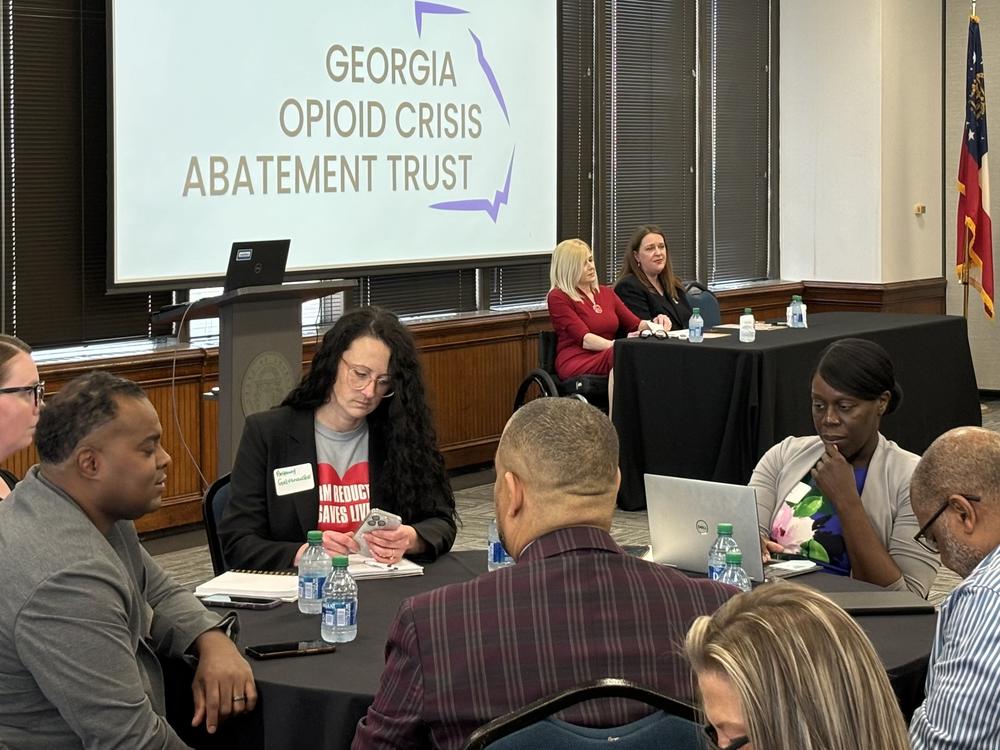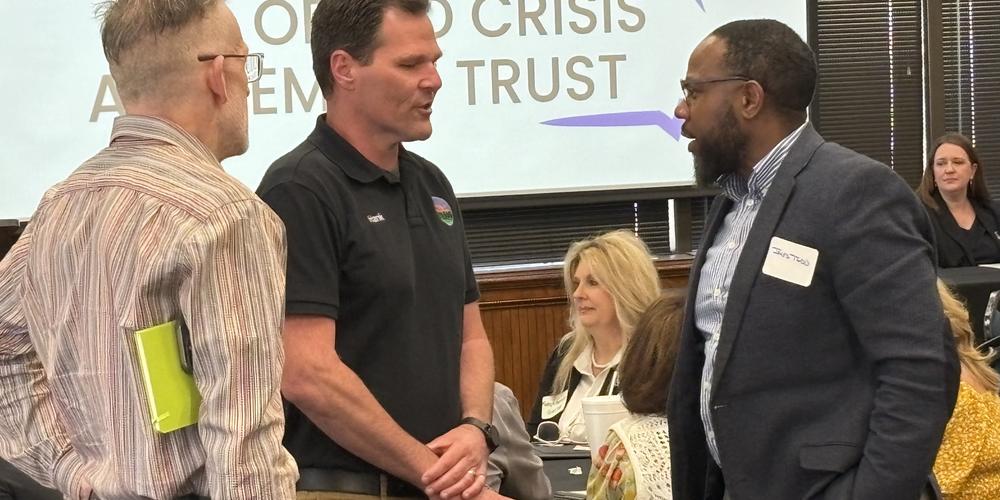
Caption
People wait for an update at a meeting April 8, 2024, for the Georgia Opioid Crisis Abatement Trust.
Credit: Ellen Eldridge / GPB News
LISTEN: Georgia’s piece of a $26 billion multistate opioid lawsuit settlement is $638 million. Grant money from the settlement will soon be accessible to providers via a website launched Monday by the Georgia Department of Behavioral Health and Developmental Disabilities. GPB’s Ellen Eldridge explains.

People wait for an update at a meeting April 8, 2024, for the Georgia Opioid Crisis Abatement Trust.
The Georgia Department of Behavioral Health and Developmental Disabilities launched a website Monday with information about how to apply for grants related to the state's $638 million opioid settlement dollars.
These national settlements have now been finalized and payments have already begun in Georgia, DBHDD Commissioner Kevin Tanner said Monday, April 8.
A quarter of that money already went out to local governments and participating groups in the lawsuit with Cardinal, McKesson and AmerisourceBergen — the nation’s three major pharmaceutical distributors — and opioid manufacturer and marketer Johnson & Johnson.
The National Manufacturers and Distributors Settlement Agreement for $26 billion requires the money go to opioid prevention, treatment, recovery, and harm reduction programs.
This includes residences for people to live temporarily after in-patient treatment of opioid use disorder.
People in recovery need that extra step that Taylor Hagin said Safety Net Recovery in Atlanta provides.
That's what he wants help with from the National Manufacturers and Distributors Settlement Agreement.
"You need that to bridge that gap between getting sober and independent living," Hagin said.
Many families and individuals pay a whole lot of money to go to inpatient rehabilitation facilities and intensive outpatient programs, he said.
"Treatment's great, but let's be real: treatment's nothing more than stabilization and a little bit of education," Hagin said. "The real recovery happens when they come to a recovery residence."
Money to address the ongoing opioid epidemic comes from the companies that profited most during the opioid crisis.
Georgia got its first major settlement award in February 2022 when McKinsey & Company settled for its role in helping Purdue Pharma market the addictive and deadly opioid medication OxyContin.
The roughly $11 million marked the first time Georgia — or any other state — received such substantial payment to address the opioid epidemic.
The lawsuit, filed in 2021, alleged executives specifically crafted messages for sales representatives to convince doctors and people prescribing OxyContin the drug was safe and effective.

DBHDD's Cassandra Price presents applicant tips for opioid settlement dollars at a meeting April 8, 2024.
The governor’s office distributed those funds through Memorandums of Understanding (MOU) between the departments of Law, Behavioral Health and Developmental Disabilities (DBHDD), and Public Health (DPH).
A $2 million contract with Shatterproof set up a two-year public awareness campaign targeting stigma reduction and opioid misuse prevention.
DBHDD also allocated $3.25 million for detoxification services such as adding beds to its existing facilities.
Georgia has a total of 546 adult crisis beds and 74 child crisis beds are available within 14 adult Behavioral Health Crisis Centers (BHCC), nine adult Crisis Stabilization Units (CSU), four Crisis Stabilization Units for children, and one Crisis Stabilization Unit for Georgians with Autism.
The 22 Community Service Boards across Georgia serve people with serious mental illness, intellectual/developmental disabilities, and/or addictive diseases who have no insurance and limited to no means to pay for treatment.
Another $1 million went to support training on naloxone (Narcan) administration and safety, specifically among community-based treatment and recovery providers. Those providers that already have the training, staff capacity, and ability to offer Medication Assisted Treatment (MAT) received $4.75 million to expand services.
Janssen/Johnson & Johnson’s $118 million settlement will be disbursed on a nine-year plan, and another $517 million from pharmaceutical distributors McKesson, Cardinal Health, and AmerisourceBergen will be paid over 18 years.
The state received 75% of that money and the remaining 25% went directly to participating local governments.
All cities, counties sheriff's offices, community service boards, hospitals and hospital authorities were plaintiffs in such a manner that, in the settlement, they got funds shipped directly.

Riley Kirkpatrick shows off the Access Point of Georgia T-shirt that his partner wears.
Gov. Brian Kemp appointed Tanner as the trustee for the state’s settlement money, which includes $191 million for regional use.
While Tanner is the chief administrative officer in charge of the grant process for the Georgia Opioid Crisis Abatement Trust, he is limited by the terms of the settlement agreement.
The proverbial buck stops with Tanner, but his office isn't involved in directing money to specific organizations.
Participating local governments to Georgia’s Opioid Distributor Settlement, including cities, counties, submitted their recommendations for Regional Advisory Council (RAC) council members.
Seven members of each RAC would include an academic member with a school of public health or nursing; a substance use provider licensed by the Department of Community Health; a sheriff or representative appointed or designated by the sheriff; a representative from the judiciary; an executive director with one of the state’s 16 community service boards; and a person with lived experience.
These are the people who will review and rate grant applications made through the website portal, and make suggestions to Tanner about the best way to invest in opioid abatement.
After an estimated 30-day application period, another two months' time is granted for review. Funding decisions should be available by fall.
Organizations that receive funding will submit quarterly reports through the same application portal.
Riley Kirkpatrick said harm reduction saved his life.
Now he and his partner run Access Point of Georgia in Athens, which serves 30 counties.
"We are the only peer-led, community-based harm reduction program in Georgia," Kirkpatrick said. "We're looking to expand specifically harm reduction."





Taylor Hagin speaks with Jeff Breedlove



DBHDD Commissioner Kevin Tanner (center) presents information. Left: Melissa Malcolm; Right: Cassandra Price

Henry Craig stands before a table of opioid settlement stakeholders April 8, 2024.
















